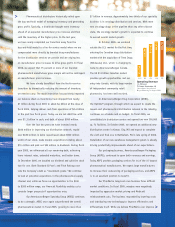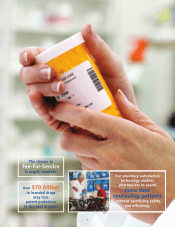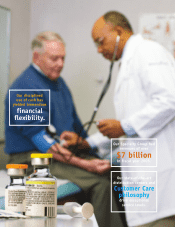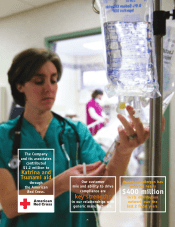AmerisourceBergen 2005 Annual Report Download - page 15
Download and view the complete annual report
Please find page 15 of the 2005 AmerisourceBergen annual report below. You can navigate through the pages in the report by either clicking on the pages listed below, or by using the keyword search tool below to find specific information within the annual report.
AmerisourceBergen Corporation 2005
-13-
AmerisourceBergen Corporation 2005
The following discussion should be read in conjunction with the
Consolidated Financial Statements and notes thereto contained herein.
The Company is a national pharmaceutical services company
providing drug distribution and related healthcare services and
solutions to its customers. The Company also provides pharmaceuticals
to long-term care and workers’ compensation patients.
The Company is organized based upon the products and services
it provides to its customers, and substantially all of its operations are
located in the United States. The Company’s operations are comprised
of two reportable segments: Pharmaceutical Distribution and
PharMerica.
Pharmaceutical Distribution
The Pharmaceutical Distribution reportable segment includes the
operations of AmerisourceBergen Drug Corporation (“ABDC”) and the
AmerisourceBergen Specialty and Packaging groups. The operations of
the former AmerisourceBergen Technology Group became a part of the
overall ABDC operations in fiscal 2005. The Pharmaceutical Distribution
reportable segment is comprised of two operating segments: ABDC
and AmerisourceBergen Specialty Group (“ABSG”). The ABDC operating
segment includes the operations of the AmerisourceBergen Packaging
Group. Servicingboth pharmaceutical manufacturers and healthcare
providers in the pharmaceutical supply channel, the Pharmaceutical
Distribution segment’s operations provide drug distribution and related
services designed to reduce costs and improve patient outcomes
throughout the United States and Puerto Rico. The drug distribution
operations of ABDC and ABSG comprised over 90% of the segment’s
operatingrevenue and over 80% of the segment’s operating income
in fiscal 2005.
ABDC distributes a comprehensive offering of brand name and
genericpharmaceuticals, over-the-counter healthcare products,
and home healthcare supplies and equipment to a wide variety of
healthcare providers, including acute care hospitals and health
systems, independent and chain retail pharmacies, mail order facilities,
physicians,clinics and other alternate site facilities.
ABDC is in a business model transition with respect to how
manufacturers compensate us for our services. Historically, supplier
arrangements allowed us to generate gross profit in several ways,
including cash discounts for prompt payments, inventory buying
opportunities, rebates,inventory management and other agreements,
vendor program arrangements, negotiated deals and other promotional
opportunities. A significant portion of ABDC’s gross margin had been
derived from our ability to purchase merchandise inventories in
advance ofpharmaceutical price increases and then hold these
inventories until pharmaceutical prices increase, thereby generating
alarger gross margin upon sale of the inventories. Over the last two
years,pharmaceutical manufacturers have been increasing their control
over the pharmaceutical supply channel by using product allocation
methods,including the imposition of inventory management agree-
ments (“IMAs”). Under a typical IMA arrangement, the Company is
compensated based on specific contract defined formulas for maintain-
ing a certain level of inventory for a pre-defined period prior to, as
of, or subsequentto the date of a manufacturer price increase. The
payment is triggered upon the manufacturer price increase and is
recognized as a reduction of cost of goods sold over the longer of the
product sell-through period or post-price increase monitoring period.
Because the payment trigger is the date of the manufacturer price
increase and the size of the payment is typically dependent on the
percentage price increase, changes in manufacturers’ pricing patterns
can cause significant volatility to the Company’s periodic earnings.
Additionally, pharmaceutical manufacturers imposed restrictions on
our ability to purchase their products from alternate sources and have
been requesting more product and distribution sales data from us.
Effective October 1, 2005, the Company voluntarily made a decision
to purchase all pharmaceuticals only from manufacturers in an effort
to further protect the integrity of the supply channel.
All of the above has led to significant volatility in ABDC’s gross
margin and, therefore, we are continuing our efforts to shift our
pharmaceutical distribution business to a fee-for-service model where
we are compensated for the services we provide manufacturers versus
one that is dependent upon manufacturer price increases (as is the
case with the IMA model). We continue to work with our pharmaceuti-
cal manufacturer partners to define fee-for-service terms that will
adequately compensate us for our services, such as our distribution
services,inventory management, service level management, and other
services. Under a typical fee-for-service agreement, the Company is
compensated for its services based on a percentage of purchases over a
defined time period. Amounts due for services rendered in the current
period would typically be earned in the following month as a reduction
of cost of goods sold as the related product is sold. As of September
30, 2005, we have signed agreements with a number of the large
branded pharmaceutical manufacturers that we consider fee-for-service
arrangements as well as some that we consider hybrid agreements
with someattributes ofIMAsandsome attributes of fee-for-service
arrangements. We believe the transition to a fee-for-service model will
improve the efficiency of the supply channel and may establish a more
predictable earnings pattern for ABDC, while expandingour service
relationship with pharmaceutical manufacturers. The fee-for-service
arrangements may establish a morepredictable earnings pattern
because under many of the agreements the Company earns a fee for its
services performed on a monthly basis in contrast to the IMA model
where earnings are largely predicated upon the timing and amount of
pharmaceutical price increases. We continue to have discussions with
pharmaceutical manufacturers regarding fee-for-service arrangements
and expect to have agreements in place with a substantial majority of
the large branded manufacturers by the end of calendar 2005. During
fiscal 2006, we expect that more than 75% of ABDC’s brand name
manufacturer gross margin will not be contingent on manufacturer
price increases. The business model transition has had the effect of
reducing merchandise inventories because IMA and fee-for-service
agreements both limit the amount of inventory we can carry and, as
aresult, we have experienced a significant increase in cash flow from
operations. The majority of the reduction in merchandise inventories
has been realized as of September 30, 2005 as days held in inventory
have decreased from 50 days during the fourth quarter of fiscal 2003
to 42 days during the fourth quarter of fiscal 2004 to 32 days during
the fourth quarter of fiscal 2005. In fiscal 2006, we would expect
merchandise inventories to stabilize as the large majority of branded
manufacturers are expected to be under some form of fee-for-service
contract and, as a result, we would expect future cash flow from
operations to track more closely to net income.
ABDC also provides scalable automated pharmacy dispensing
equipment, medication and supply dispensing cabinets and supply
Management’s Discussion and Analysis
of Financial Condition and Results of Operations
























